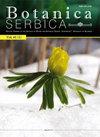The wild raspberry in Serbia: An ethnobotanical study
IF 1.1
4区 生物学
Q4 PLANT SCIENCES
引用次数: 1
Abstract
An ethnobotanical survey of the traditional use of the wild raspberry (Rubus ideaus) was conducted on nine sites in the regions of southwest (SWS) and southeast (SES) Serbia. The regions studied belong to mountainous rural areas in Serbia, mainly populated by Serbian people of the Orthodox faith. In total, 93 respondents were interviewed about the medicinal, food and cosmetic uses of the wild raspberry. In terms of plant parts in traditional use, the leaf and fruit are known to be used frequently. The dry leaf is more commonly used in the SES (78%) than in the SWS (25%) region. In the SWS region, the most frequent use of the wild raspberry leaf is linked to gastrointestinal disorders and prostate inflammation. In the SES region, the leaves are mostly used for the prevention and healing of gynecological disorders during both pregnancy and lactation. The local population of the SWS region uses the fruits mainly for the preparation of syrup juice (92%), fruit preserves (42%) and in desserts (62%), while in the SES area the fruits are most frequently used for the preparation of nonalcoholic (97.4%) and alcoholic beverages (35.9%). Our results provide some novel information on the use of the wild raspberry in Serbia and in the Balkans, such as for the treatment of prostate inflammation, use during breastfeeding and to alleviate inflammation of the eyes.塞尔维亚野生覆盆子:民族植物学研究
在塞尔维亚西南部(SWS)和东南部(SES)的9个地点对野生覆盆子(Rubus ideaus)的传统利用进行了民族植物学调查。研究的地区属于塞尔维亚的山区农村地区,主要由信仰东正教的塞尔维亚人居住。总共有93名受访者接受了关于野生覆盆子的药用、食品和化妆品用途的采访。就传统用途的植物部分而言,叶子和果实被认为是经常使用的。干叶在SES地区(78%)比SWS地区(25%)更常用。在SWS地区,最频繁使用野生覆盆子叶与胃肠道疾病和前列腺炎症有关。在SES地区,叶子主要用于预防和治疗怀孕和哺乳期间的妇科疾病。SWS地区的当地人口主要将水果用于制作糖浆汁(92%)、水果蜜饯(42%)和甜点(62%),而在SES地区,水果最常用于制作无酒精饮料(97.4%)和酒精饮料(35.9%)。我们的研究结果为塞尔维亚和巴尔干地区的野生覆盆子的使用提供了一些新的信息,例如用于治疗前列腺炎症,在母乳喂养期间使用和减轻眼睛炎症。
本文章由计算机程序翻译,如有差异,请以英文原文为准。
求助全文
约1分钟内获得全文
求助全文
来源期刊

Botanica Serbica
Agricultural and Biological Sciences-Plant Science
CiteScore
1.40
自引率
12.50%
发文量
17
审稿时长
34 weeks
期刊介绍:
Botanica Serbica publishes original research papers on all aspects of plant, fungal and microbial biology research including the disciplines of microbiology, mycology, lichenology, bryology, flora, vegetation, biogeography, systematics, taxonomy, plant biotechnology, plant cell biology, plant ecology, environmental plant biology, forestry, genomics, horticulture, limnology, metabolomics, molecular biology, proteomics, virology, plant conservation and protection, and wildlife and ecosystem management.
 求助内容:
求助内容: 应助结果提醒方式:
应助结果提醒方式:


